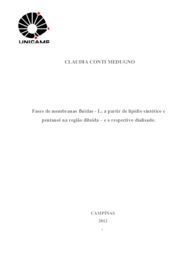Fases de membranas fluidas -L3 a partir de lipídio sintético e pentanol na região diluída - e o respectivo dialisado.
Fases de membranas fluidas -L3 a partir de lipídio sintético e pentanol na região diluída - e o respectivo dialisado.
Author(s): MEDUGNO, C. C.
Summary: Abstract: The amphiphilic L3 (sponge) phase was observed in the late 80's and represents a new class of self-assembly for surfactant-water systems. This work describes the discovery and subsequent characterization of a ternary phase composed of synthetic cationic lipid dioctadecildimetil ammonium bromide (DODAB), pentanol and water in a diluted region. This is the first description of a L3 phase prepared from a lipid with a relatively small polar head and two hydrocarbon chains with 18 carbons each one. The region of the triangle diagram in which there is L3 phase was characterized using optical isotropy and anisotropy to a probe with electron paramagnetic resonance spectroscopy technique. The proposal of an L3 phase was made by comparison with a similar system reported by the group of Montpellier. The description accepted is that in a narrow close ratio of surfactant/cosolvent concentrations, membrane fusion occurs with the formation of a highly interconnected and randomly distributed network of bilayers in space. The assumption of formation of the L3 phase is that the hydroxyl group of pentanol pairs with the lipid heads and this fact is able to change the bilayer curvature. The various DODAB/pentanol preparations remained unchanged and stable for five years only up to the concentration of 3 mM of lipid, the maximum concentration that can be called L3 phase, which is thermodynamically stable. To make the system more attractive for many potential uses it was necessary to increase the weight of the lipid. Concentrations up to 10 millimolar, after a few hours, break down into tiny droplets and small crystals, so-called multiphase. The next step was to completely remove the alcohol by continuous dialysis. The result was the appearance of a phase similar to water, which cannot be obtained otherwise. A sequence of spectroscopic and chromatography measurements showed that the alcohol was entirely eliminated by dialysis as the lipid was retained. There is a notable change when compared with other DODAB/water binary preparations. In the same concentration, all of them have pronounced turbidity. The hypothesis is that the presence of alcohol in the bilayer promotes reorganization, transforming a particulate into a bicontinuum system. Efforts to characterize these systems are justified because they are easy to prepare and have potential uses in the synthesis of inorganic solid new materials with nanostructured pores, and as drug carriers and vehicles for the crystallization of proteins.
Publication year: 2012
Types of publication: Theses
Unit: Embrapa Environment
Keywords: Membrana, Membranas líquidas, Physical-chemistry, liquid membranes
Observation
Some of Embrapa's publications are published as ePub files. To read them, use or download one of the following free software options to your computer or mobile device. Android: Google Play Books; IOS: iBooks; Windows and Linux: Calibre.
Access other publications
Access the Agricultural Research Database (BDPA) to consult Embrapa's full library collection and records.
Visit Embrapa Bookstore to purchase books and other publications sold by Embrapa.

